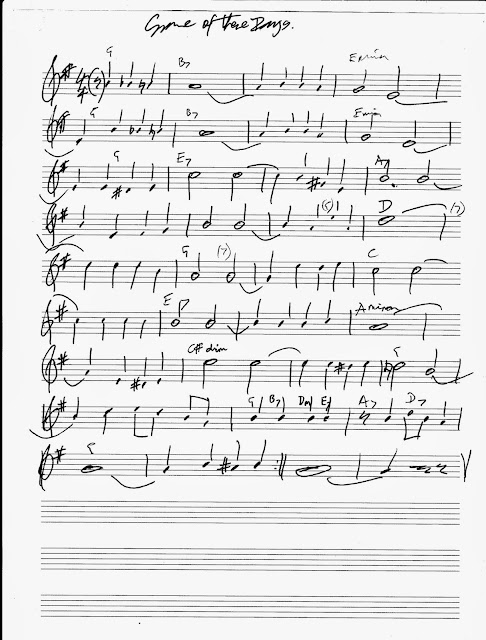The golden age of American popular music - not just jazz, but the popular songs even people who didn't like jazz listened and danced to, and which were often then taken as vehicles by jazz players - (Jazz is omnivorous) was the first half of the twentieth century. A common feature of these songs is daring harmony; quite often the melody note is accompanied by a chord to which it doesn't even belong. I first noticed this - though I must have semi-consciously enjoyed it thousands of times before; most people are not conscious of more than the melody, though the harmonies are working on them - in Kurt Weill's 'September Song', but yesterday I was looking at 'Some of these Days' (incidentally a favourite of Jean-Paul Sartre's, though that may not be a recommendation) and saw it again. Here's the melody line, with the chords (I have left out a few inessential ones) marked above:
We're in G major, and the first change is to the mediant major chord (with a seventh.) It fits the melody, and is a change well-known to players of American popular music. Used judiciously it never fails to do something to us; it hits a spot the obvious harmonization with the tonic chord can't reach. You hear it right at the start of, e.g., 'Nobody knows you when you're down and out' and 'T'ain't nobody's business if I do.' Players of more folkey guitar styles will know it as the change that happens when you reach the refrains of 'Freight Train' and of 'Cocaine'. People of a popular 'classical' taste will know it from the third, the best-known, of Liszt's 'Liebestraume'. (Sorry; the blog window doesn't seem to allow for umlauts.) So far so (fairly) conventional. But look at bar ten, where the melody goes up to a C, but the chord underneath it is an E7th, none of whose notes is a C, and anyway it would have (to match E) to be a C#. What was the composer thinking of? Well evidently he knew what he was about, because even, or perhaps because, it breaks all the rules, it sounds great. And then, two bars later, he hits us with an A7th under the melody note - a sustained one, as before - of B. This is not too outrageous; it makes a 'ninth' chord. But it's certainly not the obvious choice. Now look a couple of lines further down: a repeated long E, so one expects the subdominant C chord, (or, if one is beginning to expect the unexpected, perhaps an E7th again.) But what we get is that most dramatic of chords, a diminished 7th, the one that runs C#-E-G-Bflat. (Since diminished sevenths divide the octave into four exactly equal steps, there are only three of them). Then right near the end, the coup de grace: the melody is, here, simply repeated crotchet Bs, but the chords under them are G, B7th, D minor, and E7th. Fair enough, the note B is in three of those, and the E7th takes us nicely on to an A7th, which then resolves onto the dominant seventh, D7th, so that we can hit the repeat bar on the tonic and go back to the top again. But D minor? Totally out of order, but, yet again, it sounds great.
People such as myself and, I hope, a few others of an analytic (did someone say 'pedantic'?) turn of mind like to know, as far as it's possible, (which admittedly isn't very far) just why the music that sounds great does so. I have heard even accomplished musicians say that such an analytic approach must surely reduce one's true enjoyment of the music. Keats, who with his medical training ought to have known better, made a similar complaint about Newton's analysis of the rainbow. No; knowing how things work increases one's joy in them.


No comments:
Post a Comment